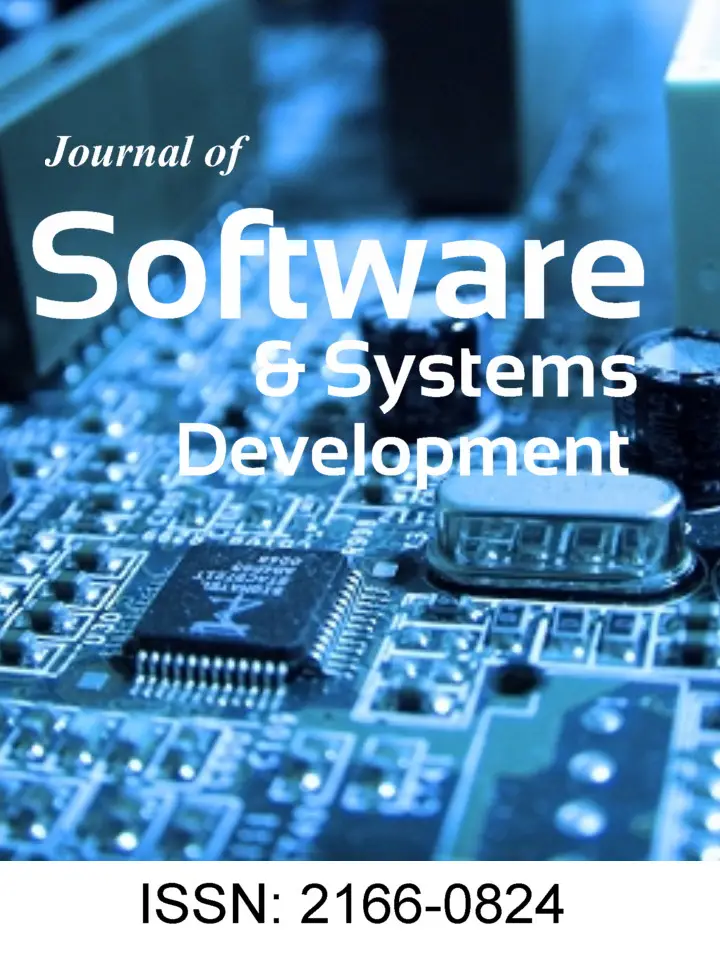Introduction
In software manufacture, throughout the software process (Pressman, 2010), specifically in the systems analysis activity, the systems and informatics engineer must have a sensory sensitivity to the context of the problem to identify, describe, organize, relate and synthesize the software requirements within their mental space in a complex and often deeply abstract way; managing to obtain, with strenuous efforts, the software in terms of requirements, which are inputs for the next system design activity.
The capacities executed in the mental space are developed in their natural language at a level of colloquial and / or common use, without a theoretical base of applied sentence structure and with a confusing logic of the application of use cases (only to knowledge graphic icons and symbols); situation that leads to an analysis of software requirements in a mental space of abstract empiricism with subjective features, causing enormous complications in the modeling of software requirements based on use cases.
For Aristotle, logic and language are closely related (Ruiz, 2015). If language is made up of signs with which we express (in a spoken or written way) our thinking, logic allows us to analyze certain uses of that language, specifically those related to the creation and transmission of knowledge. This problem, the aforementioned philosophical basis and the pertinent knowledge have made it possible to establish a synergistic relationship between the sentence structure of the Spanish language and the logic of use cases for the identification and description of software requirements as a pedagogical strategy to facilitate the management of the abstraction in requirements modeling through use cases
Materials and Methods
This research is of a quantitative approach, experimental type, explanatory level and pre-experimental design, carried out on a group of 28 students of the Systems Engineering and Informatics career, to whom the Document Measurement Instrument “Components of the modeling software requirements”, which consists of 11 items, which systematically relate logic and language in the framework of modeling software requirements. Where the independent variable is studied: logical-language synergy of the ordinal polytomous type and the dependent variable, modeling of nominal dichotomous software requirements. The Document Measurement Instrument was applied in a pilot to 10 students of the Systems Engineering and Informatics career to later verify the reliability of the aforementioned with Cronbach’s Alpha. Subsequently, it was submitted to the Judgment of three experts and the Kendall Coefficient was applied to measure the degree of agreement between several judges.
For the normality analysis, the Shapiro-Wilk Normality test was applied for the study variables, where P-value in each of the cases is P> α (0.05 – the null hypothesis is not rejected), so that observations are normally distributed. Regarding the general objective of the research, it was obtained as a result that the P-value in the ANOVA table is less than 0.05, so there is a statistically significant relationship between the modeling of software requirements (Proposed methodology) and the modeling of software requirements (previous methodology), with a confidence level of 95%. Likewise, when performing the homoscedasticity test in the comparison of means, it was obtained that the calculated P-value is less than 0.05, therefore, the null hypothesis is rejected in favor of the alternative hypothesis, thereby corroborating the general hypothesis of the investigation. Ha = The logic-language synergy improves the modeling of software requirements in Peruvian students of Systems Engineering and Informatics. All these analyzes have been carried out with the support of the statistical software IBM SPSS statistics 25.
In addition, for the analysis of the research, the deductive method has been used whose research strategy was the synergistic review of the theoretical bases based on Aristotelian Thought, Chomsky’s linguistic creativity and the Maturanian Language Theory.
Research Motivation
In software manufacture, throughout the Software Process (in our case Life Cycle), specifically in the System Analysis activity, the Systems Engineering and Informatics student must identify, describe, organize, relate and synthesize the system requirements within your mental space in a complex and often deeply abstract way; managing to obtain, with strenuous efforts, a software in terms of requirements, which are inputs for the next activity of System Design as another fundamental activity of the Software Process within the framework of Software Engineering.
The capacities executed in the mental space of the student, many times of deep abstraction, are developed in the Spanish language at a level of colloquial and / or common use without a guideline and theoretical basis of applied grammatical structure. Which leads to a subjective perception, identification and description of software requirements, causing enormous complications in the modeling of software requirements and future activities of the software process.
Synergy, logic-language for thought
For the analysis of the research, the deductive method has been used, whose research strategy was the synergistic review of the theoretical bases based on Aristotelian Thought, Chomsky’s linguistic creativity and the Maturanian Language Theory.
In the first instance Ruiz (2015) states: there is the relationship between language, logic and thought, which is one of the great findings of Aristotle, the same one who maintains that from the senses that experience recovers, as a source of certain data, logic and language are going to be fundamental. The logic studies the form that a certain type of argument must have, those that pretend to demonstrate or prove something; it shows what paths thought follows when it acts; Likewise, it is observed that the basic element is language through words, with which we refer to realities through sentences to express or think combinations between these realities. For his part, Chomsky points out that the fact that people are able to communicate means that there is something in our minds that allows us to do so. One way to define this position is to call it “rationalist”, that is, to attribute a primary role to reason in our relations with experience. Giving primacy to reason over experience is like saying that experience and the world provide us with the data, but that we do not get to them without intermediaries, but rather through a structure that determines the way we perceive, or in which our mind processes that data; and it is this structure that we must verify and discover (Versace, 2016)
Likewise, the Maturanian Theory of Language establishes that acquiring awareness of something implies reflecting objective reality through generalized meanings that have been objectified in the word. The link between thought and language, therefore, is intimate and necessary, since the semantic expression of meanings of thought is given in language (Ortiz, 2016)
From these statements, a guiding concept is proposed, which is the basis for the approach, presentation and development of capacities that help the student in the sensitive identification, description, relationship and diagramming of components for the modeling of software requirements. The concept proposed in this research tells us: that the experiences of reality are perceived by the senses, through information, data and that in the synergistic link between; a structure – intermediaries (being the logic and logic of use cases, for example) and the language (semantic expression of meanings), a conscious reason (thought) is reached that contributes to the modeling of software requirements.
Abstraction methodology for modeling
For the generation of knowledge, based on the proposed guiding concept, and making it operational, 3 stages are proposed:
- Initial moment. It is the writing of the business process, perceived by the senses and the knowledge generated in the mental space of the student, which must be processed in a logical way, with the conception of statements and written under the structure of the sentence. First, a framework description of the business process is made and then sentences are detailed as the subjects appear, in the environment of the main actions that they carry out called Thematic sentence (Tavera, 2016) and later the secondary or extension actions called Development sentences (Tavera, 2016), which are the details of the topic sentence, a description that is shown in Fig 1
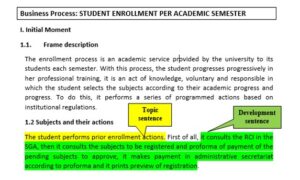
Fig 1. Initial moment
- Intermediate moment. Starting from the products of the initial moment, thematic sentences and development sentences and relying on the Matrix of thematic sentences and development sentences, the subjects, main actions and detailed actions are structured correspondingly, as shown in Table 1.
Table 1: Sentence matrix – moment in between

- Final moment. Using the results of the Matrix of topic sentences and development sentences and considering the following relationship between the elements of the sentence (language) and the symbols of the use case diagram of the UML modeling language, as shown in Table 2.
Table 2: Relationship between language and UML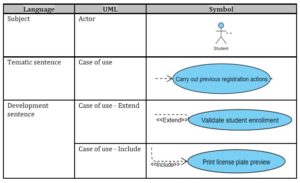
We proceed to develop the diagram of use cases, resulting in the following diagram for the case of the Student actor, as can be seen in Fig. 2
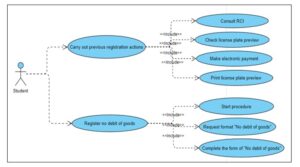
Figure 2. Resulting use case diagram
This is the product that the student would obtain in the modeling of the software requirements.
Discussion of Results
Vargas (2015) proposes in his doctoral thesis “Model for the specification of initial software requirements from the syntactic and semantic relationship between objectives and problems”, a model for the specification, formalization and relationship of organizational objectives, problems of the domain and objectives of the system in the phase of software requirements reduction, allowing to generate traceability and consistency. A set of syntactic and semantic rules is structured that facilitate an association relationship of common domain terms.
The proposal of this research proposes a guiding concept, which is the basis for the approach, presentation and development of capacities that help the student in the sensitive identification, description, relationship and diagram of components for the modeling of software requirements. The concept proposed in this research tells us that the experiences of reality are perceived by the senses, through information, data and that in the synergistic link between; a structure – intermediaries (being logic and logic of use cases, for example) and language (semantic expression of meanings), a conscious reason (thought) is reached that contributes to the modeling of software requirements, by means of a value chain consisting of three moments.
- Initial moment. It is the writing of the business process, perceived by the senses and the knowledge generated in the student’s mental space, which must be processed in a logical way, with the conception of statements and written under the structure of the sentence.
- Intermediate moment. Starting from the products of the initial moment, thematic sentences and development sentences and relying on the Matrix of thematic sentences and development sentences, the subjects, main actions and detailed actions are structured correspondingly.
- Final moment. Based on the results of the Matrix of topic sentences and development sentences and considering the following relationship between the elements of the sentence (language) and the symbols of the use case diagram of the UML modeling language.
Regarding the general objective of the research, it was obtained as a result that the P-value in the ANOVA table is less than 0.05, so there is a statistically significant relationship between the modeling of software requirements (Proposed methodology) and the modeling of software requirements (previous methodology), with a confidence level of 95%. Likewise, when performing the homoscedasticity test in the comparison of means, it was obtained that the calculated P-value is less than 0.05, therefore, the null hypothesis is rejected in favor of the alternative hypothesis, thereby corroborating the general hypothesis of the investigation. Ha = The logic-language synergy improves the modeling of software requirements in Peruvian students of Systems Engineering and Informatics
By applying the logic-language synergy, the modeling of software requirements improves in Peruvian students of Systems Engineering and Informatics, in the 2019-1 semester, where it can be seen that the average of the students’ evaluations was 14.3214, improving regarding the 2018-1 semester grades, since the average of the students’ evaluations was 10.1622, where the logical-language synergy was not applied. These results can be seen in Fig 3.
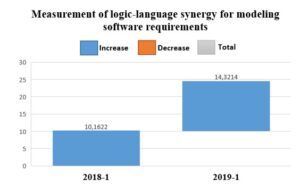
Fig 3. Result of the improvement of the logic-language synergy
References
- Ortiz A. (2016) La investigación según Humberto Maturana. El amor y la autopoiesis como epistemología y métodos de investigación, Cooperativa Editorial Magisterio
- Pressman, R S. (2010) Ingeniería de software: un enfoque práctico, Mc Graw Hill, México
- Ruiz T P. (2015) Aristóteles: De la potencia al acto, Bonalletra Alconmpras S.L., Barcelona
- Tavera E and Robertson K (2016) Taller de escritura e interpretación de textos, Pontificia Universidad Católica del Perú, Lima
- Vargas F. (2015) Modelo para la especificación de requisitos iniciales de software a partir de la relación sintáctica y semántica entre objetivos y problemas, Master thesis, Universidad Nacional de Colombia – Sede Medellín
- Versace S. (2016) Chomsky lenguaje, conocimiento y libertad, Alcompras S L., Barcelona



